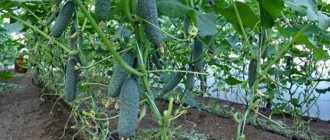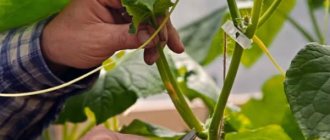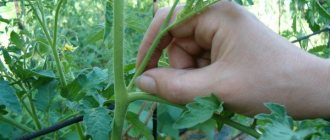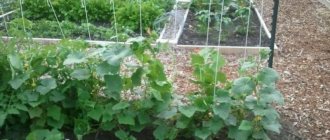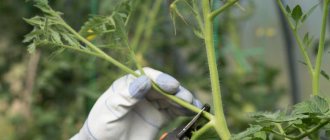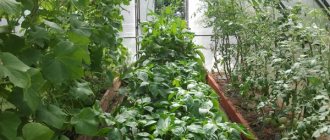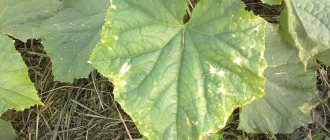Cucumbers are those green vegetables that we can quench our thirst with; we can add them to a salad, preserve them or ferment them for the winter. Cucumbers can be grown in heated greenhouses all year round, but in unheated greenhouses they ripen almost first among vegetables, second only to radishes and green onions. Read our article on how to form cucumbers in a greenhouse step by step.
Limited space in greenhouses sometimes becomes a factor that does not allow us to get a full harvest from each cucumber bush. But if you organize a full feeding of the minerals necessary for cucumbers, good care and specific shaping of the bushes, then it is quite possible that the harvest will be exactly what this or that type of cucumber is designed for.
Why do you need to shape and pincush cucumbers?
In order to unlock the full potential inherent in a particular cucumber by breeders, it is not enough to simply buy seeds and grow plant seedlings. Sometimes the cause of failure is the incorrect formation of cucumber bushes. It happens that gardeners completely neglect this agricultural technique, aimed at increasing the yield of some garden crops. The formation of plant bushes involves tying, pinching and pinching the stems as they grow.
What is stepsoning
The primordia of the lateral stems, which begin to grow from the axils of the leaves, are called stepsons. Stepping involves the removal of these processes. The need to remove some stems arises from the fact that in a limited space or due to the genetic tendencies inherent in the plant, it does not have the opportunity to enlarge its root system to such an extent that it can provide nutrition to all the stems, leaves and fruits.
For fruiting, the lateral shoots need to receive the same amount of microelements as the central stem. Peduncles, ovaries and developing fruits should receive the same nutrition. By pinching, the gardener redirects nutrients to the fruits growing on a specific, specially selected stem. As a result, the plant devotes all its strength not to lateral shoots with many weak and small ovaries, but to just one or several, on which large, fully ripe and tasty vegetables will grow.
Limit the growth of cucumber stems by pinching the growing point. This technique is used to increase and accelerate the ripening of the crop and to reduce the length of the vine. After the plant stops increasing its length, it begins to actively branch - increase the number of lateral processes. In this case, the method of stepsoning can become either inevitable or harmful.
Features of the formation of parthenocarpic varieties
When choosing seeds, pay attention to what type of cucumber variety it is:
- insect-pollinated;
- parthenocarpic (self-pollinating).
The main difference is the female flower on self-pollinating varieties, which has ovaries in the form of a small cucumber. These varieties do not require pollination assistance from insects or humans.
When planting seedlings, prepare twines hanging from above to tie up the bushes. Do not overtighten so that the plants do not pull out of the soil. Wrap the stem loosely around the support, preferably under each leaf, so that in the future it does not break off under the force of the gravity of the fruit.
Remove side shoots, flowers and ovaries from the lower tiers. When the bush reaches 30 cm, pinch the side shoots to 5-6 leaves. Next - above the first leaf of each ovary.
When the cucumber vine reaches the crossbar, it is thrown over and it grows down . Pinching is done already on 2-3 leaves. When 1 meter remains between the soil and the vine, it is pruned, stopping growth.
Features of the formation of bee-pollinated varieties
Insect-pollinated plants have male flowers (barren flowers), which are incapable of independently forming ovaries without the participation of bees or humans.
During the flowering period , create access for insects or carry out pollination yourself . To attract bees, make a solution based on honey or jam and spray the bushes.
There is no need to pinch the main stem ; it should reach the top crossbar. In the area of the lower 4-5 leaves, all flowers and ovaries are removed. From 5-7 leaves shoots up to 20 cm are left. Then the length is increased. In the area of the crossbar itself, the shoots reach 50 cm. Having entwined the crossbar with the main stem, pinching is done.
Do not allow impenetrable vines to grow . Such plantings are poorly lit, and insect access will be difficult. Insufficient ventilation will cause bush disease.
If there is insufficient pollination of the bushes by bees, pick the male flower and touch it to the female one (it has a small ovary).
Attention! Perform all manipulations in the morning, while it is not very hot. The process is long and monotonous, but it is worth the effort.
Nuances of formation in a greenhouse
Growing outdoors and indoors are very different . In the first case, the bush grows horizontally, in the second – vertically.
With horizontal growth, the vines are located along the ground , and the foliage creates a special microclimate. The pinching process is impractical and will cause bush diseases. To prevent cucumbers from growing too much, it is more effective to pinch the main shoot.
If you observe a large number of barren flowers, pinch out the main stem and partially the side branches. This promotes the growth of second-order branches that will contain female flowers.
Vertical growing is typical for indoor greenhouses . Formation is carried out in one or several stems. As a result, the bush is better illuminated and does not occupy large areas.
Do not forget to ventilate the greenhouse for good ventilation and saturation of plants with oxygen. Provide access to bees and bumblebees that will pollinate cucumber bushes. Water them in the morning, remove dried and diseased leaves.
How to shape cucumbers correctly
By correctly forming cucumber bushes, the gardener achieves rational use of the internal volume of the greenhouse, ease of care, improved lighting conditions, optimal air circulation inside the bushes - that is, a person, by removing everything unnecessary at his own discretion, controls the growing season and fruiting of the cucumber bush.
Cucumber bushes are formed into one stem, with further branching in the upper part of the central stem, using the bush method. Formation patterns depend on the species of the plant. The formation of parthenocarpic (not pollinated at all) and self-pollinated cucumbers is somewhat different from insect-pollinated varieties and hybrids. On bee-pollinated cucumber species, ovaries are mainly formed on the side shoots, because male flowers grow on the central stem. That is, these types of cucumbers cannot form into one central stem.
To determine whether it is necessary to remove the stepsons and allow only one cucumber vine to grow, at the very beginning of the growth of cucumbers, pay attention to the buds that first appeared in the axils of the lower leaves. If ovaries appear there, therefore, this plant belongs to a parthenocarpic hybrid or self-pollinating variety. The appearance of barren flowers will indicate that the plant must be allowed to develop into a bush. Only the further growth of the vines will show where the ovaries will grow on them.
To ensure that cucumbers do not get sick and bear fruit normally, they should not be planted densely; the load on the central cucumber vine should increase gradually. The lower leaves should not come into contact with the ground, all parts of the bush should not grow chaotically. What all cucumbers have in common is that they are all climbing vines, so they require trellises and staking.
Common mistakes gardeners make
The most common mistake made by young gardeners is the omission of the method of pollination of cucumbers when choosing for planting in a greenhouse.
This characteristic should be considered especially carefully if planting will be carried out in polycarbonate greenhouses. Any variety or hybrid can be:
- Parthenocarpic;
- Self-pollinating;
- Bee pollinated.
It is possible to grow any cucumber in open beds, but bee-pollinated species are not suitable for greenhouses.
You have to additionally install a hive, and if you don’t have one, you have to lure the bees. Or even work as a bee yourself, pollinating all the female flowers with a male flower.
How to tie it correctly
The first garter of cucumber shoots is carried out when they reach the lower tier of the support net or other support device, for example, plastic tape or metal wire. Garter tapes about 25 cm long are used. When gartering, care must be taken not to uproot the seedling. The lashes are either wrapped around a support or attached to the mesh. To prevent shading of the bushes, the side lashes are attached at an angle of 30-35°.
When mounted vertically on long cords fixed under the ceiling of the greenhouse, the stem and tendrils of the plants are wound and secured with long tapes. Horizontal fastening involves arranging arcs or trellises from long pieces of wire to which cucumber vines are attached.
Garter
Cucumbers grown in protected soil need special care throughout the season. About a week after planting the seedlings, it is time to start tying up the seedlings. There are two varieties. When tying vertically, you will need a trellis at the top of the greenhouse. One end of the twine is attached to the stem of the seedling under the second leaf, and the other is attached to the structure. The stem of the plant will become thicker as it grows, so the loop should not be too tight on it. If the rope is too tight, there is a danger of pulling the stem out of the ground, and if it is too weak, it will dangle.
In the case of the horizontal garter method, the support is created using wire stretched over stakes. It looks like a ladder, where the steps are located at a distance of 30 - 40 cm from each other. As they grow, the stems are fixed to them. You can also use the now popular cucumber mesh. The plant independently climbs it with its antennae.
Important!
Using twine made from natural materials will help prevent slipping.
How to shape cucumbers
Forming is done to strengthen the plant itself and improve the development of the bush. If this procedure is performed correctly, the fruits will become large and strong. Formed bushes have a number of advantages, which include:
- saving space in the greenhouse,
- free access to each bush for watering, loosening, fertilizing or spraying,
- the stems do not touch the ground, which provides protection from rot or pests,
- convenience in picking fruits,
- free ventilation in the beds where cucumbers grow,
- correct watering,
- ease of penetration of daylight,
- more intensive growth of cucumbers.
The fruits will develop more actively and have excellent taste, but for this, gardeners should familiarize themselves with some of the nuances of this procedure.
In one stem
In this way, cucumbers with bunch fruiting are most often formed by self-pollinating and parthenocarpic cucumber species. All ovaries, stepsons, tendrils, and pedicels are removed from the first 5 leaf axils. In all subsequent nodes, only the ovaries are left and all stepsons are removed.
Forming a cucumber into one stem: video
With side shoots
Bee-pollinated varieties and hybrids of cucumbers are formed according to a multi-stem scheme. The central stem of the plant is tied to a support. From the beginning of the stem in the first 4 axils to the 5th leaf, everything is removed. The stepson is left in the fifth axil, allowed to grow and pinched after the first leaf. Along the entire length of the central stem, as it grows, all stepsons, ovaries, and flowers are removed from every 4 nodes. At every fifth node a shoot is again left.
Formation of a cucumber bush (video)
Which varieties need pinching?
It turns out that the need to shape a cucumber arises depending on its growing conditions and the selected variety. There are varieties of so-called “old” and “new” selection.
“Old” varieties, which include, for example, “monastyrsky”, “vyaznikovsky”, “Nezhinsky”, “neroshimy”, are distinguished by late ripening periods and need to stimulate the process of ovary formation. Proper pruning serves as a stimulus for the formation of new fruits.
The principle of formation of cucumber bushes of old selection varieties
But varieties of newer selection (“April”, “Zozulya”, “fontanel”, etc.) can do without a “haircut”. They give a good harvest even without formation due to the fact that the formation of side canes is minimized here.
Pinching and pruning: how to do it correctly so as not to cause harm
In order not to harm the plant, it is necessary for the cucumber seedlings to remain in the ground for at least 5 days. Tools for trimming stepsons, mustaches, ovaries and flowers must be sterilized. Work in a greenhouse can be done at any time, but the soil under the plants must first be moistened to ensure proper turgor .
What is turgor?
is a process that occurs in the cells of plant leaves and is caused by hydrostatic pressure. Translated from Latin, it means “to be filled.”
Care before and after the procedure
The best time to cut off ovaries and shoots is morning. The damage received by the plant will “heal” by evening, minimizing the risk of infection. During work in the greenhouse, you cannot turn the vines over, otherwise the bushes will die. Getting rid of dried elements of the tops will provide the cucumbers with more light.
Trimming shoots that have stopped bearing fruit is important, because they can become a source of infection. Once the parts are removed, the plant will be weakened. It can be supported by feeding. Ready-made industrial complexes and herbal infusions prepared independently will be equally useful.
Important!
If the moment of pinching was missed, you need to leave everything as is, so as not to destroy the planting due to loss of the growing point.
Methods for forming cucumbers
If you do not pay due attention to the formation of cucumbers in a greenhouse, a number of problems may arise, which include the following factors:
- all the strength and nutrition of the plants will go to extra shoots, not fruits,
- the thickening of cucumbers will create a significant barrier to the penetration of sunlight, which in turn will be an obstacle to the normal growth and development of the crop,
- when thickening occurs, a favorable environment is created for the occurrence of various diseases and the proliferation of pests,
- dense plantings make caring for the plant much more difficult,
- access of insects to dust-pollinated varieties will be difficult, which will undoubtedly affect the fruiting of the plant.
Growing difficulties
What to do if plants are rotting in the greenhouse
The main cause of this problem is waterlogging. Low temperature is a secondary cause. And so, watering with cold water, especially at night, will most likely cause the appearance of diseases.
The cucumber root system does not accept cold water, freezes, stops feeding the plant and it weakens. In damp conditions, pathogenic bacteria quickly develop, which in a matter of days will mercilessly deal with an entire cucumber plantation.
Barren flowers in greenhouses
If the cause of barren flowers is not the method of pollination, then most likely it is:
- Seeds that are too young and unhardened;
- Watering with cold water;
- Stagnation of water in the soil;
- Excess nitrogen;
- Very dense plantings.
Leaves constantly wither
Drooping foliage on cucumbers should alert the gardener. You should put everything aside and urgently help the cucumbers.
- An indoor climate that is too hot does not allow the plant to adequately consume water from the soil;
- The soil may have become depleted and there is a lack of nutrition for the crop. Basically there is not enough nitrogen. Urea should be diluted and foliar feeding should be done;
- Direct rays of the sun have a negative effect on cucumber foliage;
- Insufficient watering of the plant;
- Pest invasion. Ordinary garlic planted between the cucumber bushes will help scare off uninvited enemies;
- Presence of common diseases. Treating plants and soil with a solution of manganese and chalk will help prevent the epidemic.
There are many voids in cucumbers
There are also troubles when voids form inside the fruit. Most often this occurs from an unbalanced combination of microelements: the predominance of nitrogen is too high, and calcium, potassium and phosphorus are low.
If feeding is carried out in complexes, then the voids may signal a lack of water. Its quantity should be reconsidered.
Forming cucumbers: an easy way (video)
The formation of cucumbers in a greenhouse is divided into several stages:
- Removing side shoots and flowers in the axils of 4-5 lower leaves;
- The ovary above 4-5 leaves must be left, and the stepsons must be removed;
- If the stepsons have sprouted more than 20 cm, then removing them can lead to the shedding of the ovaries;
- After 5 more leaves appear in this area of the plant, the stepsons can be left, but you need to pinch off their tops after the first leaves appear;
- Stepchildren growing on side shoots are immediately removed;
- The top of the main stem must be pinched at the height where it hangs over the tensioned wire, when it can easily be thrown over a couple of times.
Each type of cucumber formation has its own differences.
In a polycarbonate greenhouse
Cucumber bushes in the greenhouse must be properly cared for; they must be formed in such a way that this care ensures normal taste and a good harvest of fruit. When planting seedlings, it is necessary to maintain such a distance between the bushes that one or another method of tying and pinching cucumber vines ensures that the shoots and leaves are not thickened.
Parthenocarpic hybrids
Hybrids of non-pollinated cucumber species are usually grown using the vertical staking method, forming them into one central stem.
Bouquet type cucumbers
Cucumbers of bouquet (beam) type of ovaries belong to parthenocarpic and self-pollinating hybrids. The main way to grow this type of cucumber is by vertically tying one central stem. Sometimes, if there is sufficient space in the greenhouse, at a height of approximately 1.5 m, the stepsons on the central stem are not removed and the plant is allowed to form one or two lateral shoots. In this case, it is necessary to secure a horizontal fastening made of wire or rope in the upper part of the greenhouse, to which the side shoots must be tied.
Caring for cucumbers in a greenhouse
Caring for green greenhouse vegetables should begin in the fall. During this period, the structure is sanitized, all debris is removed from the beds, and deep digging is done.
Bleach is used for disinfection. If it is planned to plant cucumbers in the previous beds for the third year in a row, then the soil is also treated with lime.
A week before the planned planting of seedlings, greenhouse beds are generously fertilized with humus.
Garter
All greenhouse cucumbers need staking. Pre-set trellises 1.5-2.0 meters high are used as supports. When the seedlings take root in the greenhouse, this will take about a week; each cucumber plant between 2 and 3 leaves is tied with twine.
Excessive tension is not recommended as it will easily damage the stem. As the cucumber grows, it is directed up the trellis. The tying loop should be generous so that over time the thickening stem is not squeezed.
Watering
When planning to grow cucumbers, you should take into account that water consumption will be measured in cubes. The very first watering is done on bare, generously fertilized soil.
Further moistening is carried out when the soil begins to dry out. You should not get carried away and pour cucumbers, otherwise they will become watery and tasteless.
The most optimal irrigation for polycarbonate greenhouses is drip irrigation. With it, each bush receives an equal share of water, the problem of drying out is put aside.
Only warm water is used so as not to expose the roots; do not water under the stem. If such a nuisance does occur, you should add soil. Even better is to mulch the plantings.
Mulch prevents the formation of crusts, maintains a constant temperature, and enhances soil aeration. They usually use fallen leaves, straw, peat, and cut dried grass.
Top dressing
During the first weeks, the emerging seedlings are fed with previously applied fertilizers. However, they need nitrogen supplementation. During flowering, cucumbers are fed with phosphorus, and when fruits begin to set, they switch to nitrogen-potassium fertilizing.
For good photosynthesis, plants need carbon dioxide. An additional source can be fresh manure placed in a large container in a greenhouse.
It is recommended to feed cucumbers in the evening, before watering. Minerals and organic matter are used. Foliar feeding is also useful for the crop.
Prevention of diseases and pests
It’s not just the plants that are comfortable in a polycarbonate greenhouse. Numerous enemies develop here much faster than in the air. Lost time can be very costly: pests and parasites instantly deal with plants.
- Whitefly. This insect feeds on sap, extracting it from the plant. It leaves behind a discharge on the foliage in which a sooty fungus settles. For preventive purposes, glue traps are placed and all weeds are eliminated. When an enemy is detected, the plants are inspected and the affected foliage is removed.
- Melon aphid. It attacks crops from mid-July. Its attacks are lightning fast; in two days the pest manages to hit almost all plantings, destroying shoots, ovaries, and foliage. When the first pests appear, all crops are treated with an infusion of pepper and tobacco.
In addition to insects, cucumbers are also affected by diseases common to all melons:
- Root rot. The affected root stops absorbing nutrition from the soil. Over time, this leads to the death of the entire plant. The situation is aggravated by the instant spread of the disease throughout the entire area of the greenhouse.
- Medyanka. The fungus affects both the leaves and fruits of the crop. The surface becomes covered with brown spots, reminiscent of ulcers.
- Powdery mildew. The virus in the form of a white coating covers the leaves of the cucumber. The impossibility of photosynthesis leads to the death of the crop.
The appearance of parasites and diseases can be caused by:
- Poor ventilation;
- Lack of crop rotation;
- Poor soil;
- Thickening of crops;
- Gross mistakes made during watering;
- Temperature failure.
Reviews
Cucumbers were planted without formation. The harvest was below average. A neighbor once suggested how to do this procedure correctly. Now the harvest is enough for the whole family. Care is not very labor-intensive, but the result of the effort is obvious. I am very pleased with this method of growing cucumbers!
Marina, 49 years old, Rostov-on-Don
I am an experienced gardener. I managed to try a lot in my greenhouse. At first it seemed that this would result in less harvest, because to form a bush in a greenhouse you need space. But after reading the works of other gardeners and spending a little time browsing gardening forums, I realized my mistake. Now I don’t save space to the detriment of the harvest. In addition, each variety requires a special approach, so you must always take into account which type of cucumber you are talking about. It is this factor that determines the planting and care of the plant.
Oleg, 52 years old, Astrakhan
The formation of a bush is a prerequisite for obtaining a good harvest. Our family has always used this method in the greenhouse. The results are beyond praise!
Tamara, 34 years old, St. Petersburg
Natalia
Author
Ask a Question
To get an excellent harvest, you need to water on time, fertilize and create favorable conditions for cucumbers. As this crop grows, it will need proper shaping, without which it is impossible to get an excellent harvest. Having completed all the procedures correctly, the gardener can count on a bountiful and tasty harvest. Health to you and your loved ones!
Morphology of a cucumber - where do the roots of the habit of forming bushes come from?
Cucumber, which belongs to the pumpkin family, differs significantly in its structure from other greenhouse crops. A humid microclimate, partial shade and the absence of drafts are important for it. After all, the cucumber arrived to us from hot India, characterized by a humid climate. That is why experienced summer residents try to grow this vegetable in a separate greenhouse.
Cucumbers are the most rewarding crop in the greenhouse
Its roots do not grow as deep into the ground as, for example, a tomato. Therefore, the formation of a cucumber bush in a greenhouse is precisely aimed at helping to strengthen the root system.
But the huge leaf surface of the plant, evaporating a lot of moisture, protects the fruits from overheating, burns and participates in their ripening. But this, in turn, creates favorable conditions for the development of fungal and other diseases. And the pinching procedure is also designed to combat this phenomenon!
Cucumber is a monoecious crop, which means the presence of both female and male flowers on one bush. There are also bisexual forms, in which each flower has both male and female organs. To obtain a large harvest, it is necessary to remove those vines on which mainly barren flowers (male flowers) grow.
On the left is a male flower (barren flower), on the right is a female
Advice from experienced gardeners
Gardeners who have a greenhouse on their summer cottage often plant it with cucumbers and willingly share their experience in developing this crop.
- If a lot of large leaves form in the upper tier of the cucumber, which shade the entire bush, they need to be thinned out - carefully cut off a few pieces, and then sunlight will penetrate to the lower tier.
- It is better to pruning and pinching bushes in sunny weather - the wounds heal much faster. Due to the increased humidity in rainy weather, wounds take a long time to heal, so there is a risk of contracting diseases.
- Bushes need to be inspected regularly, so you can see diseases and the presence of pests in the early stages of their development. All parts of plants affected by them must be cut off and burned.
All gardeners try to harvest as often as possible so that the fruits do not overripe and lose their varietal qualities, and the shoots do not break under their weight.
What can dense bushes affect?
Bushes that grow in a greenhouse on their own, without any formation, gradually turn your plantings into an impenetrable jungle, which is very difficult to work with: harvesting, processing, tying up. This is especially true for branchy bushes. Thin, elongated lashes are poorly ventilated and lit, which can provoke the occurrence of various diseases.
If you leave absolutely all the shoots on the bush, the yield will not only not increase, but will also decrease noticeably: fruits will not be able to form either on the main stem or on the side shoots. In the photo above you see one of the shoots that had female flowers. However, the fruits never formed: the ovaries began to turn yellow and dry out.
Even if you missed some stage of bush formation, it is still worth removing weak shoots that thicken the bush. And if you are afraid of injuring the bush, you can limit yourself to pinching the growth points of those stepsons that have ovaries.
When forming a bush, you should not measure the length of the shoots with a ruler and accurately calculate the number of nodes. All schemes are very conventional, and each gardener must focus on the development characteristics of the bush, the height of the greenhouse and the planting pattern. Have a good harvest!
Formation of the main stem
The harvest can be extended through simple manipulations. After harvesting the fruits, and shoots are removed from the lower part When the top of the lash has reached the top of the greenhouse, you can lower the cord on which the stem curls to the height of the peeled stem.
After this, the cord is secured again and now the cucumbers have room for further growth . In this way, you can get a harvest right up to frost.
How to form cucumbers in a greenhouse can be seen in the diagram below:
Should you trim cucumber leaves?
As is known, the process of photosynthesis occurs in the leaves, resulting in the formation of nutrients necessary for the formation of the crop. There is a generally accepted rule: near each ovary there should be a leaf that provides nutrition to the greens. You can only remove yellowed, diseased, damaged leaves, as well as those that thicken the planting too much and interfere with the ventilation of the bush. The first step is to remove the lowest leaves lying on the ground. Then the side shoots from which the harvest has already been harvested are cut off. Thus, the microclimate of the plantings will improve, and the bush will direct all its efforts to the development of new shoots.
Leaves are cut close to the stem, leaving no petioles.
